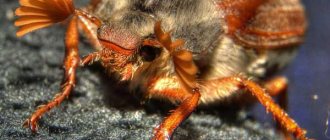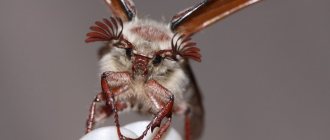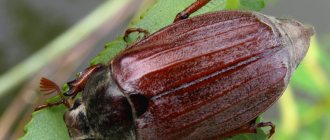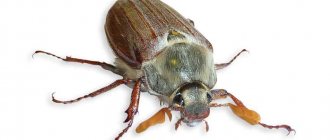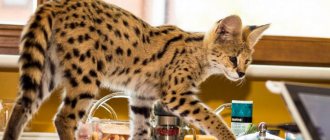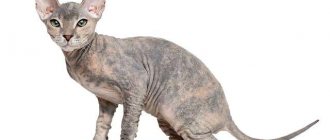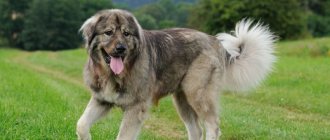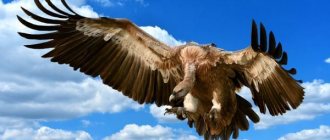- Wild animals
- >>
- Insects
If you observe, at the end of April and beginning of May you will notice that medium-sized beetles gradually crawl out of the ground and quickly fly into the air. This insect is called the cockchafer . This is the most famous pest that causes great losses in the agricultural sphere of human life. Despite this, the cockchafer is a rather interesting animal with its own habits and way of life.
Origin of the species and description
Photo: Maybug
Khrushchev is a fairly large insect. Some representatives of its genus reach thirty millimeters in length, have a characteristic wide body, black or red-brown body color. May beetles are also called beetles, and in Latin they are called Melolontha. These insects belong to the order Coleoptera and are part of the huge family Lamelidae. May beetles founded their own genus of the same name.
Video: Maybug
The Khrushchev population has experienced great leaps at different times. There were both drops and rises in the number of pests. The population was at its highest in the fifties. Then the beetles caused enormous damage to agricultural land and gardens. For this reason, farmers began to actively use pesticides to cultivate their lands. At first this significantly reduced the number of pests, then completely exterminated them. The genus of cockchafers was able to restore a high level of its population only after the eighties, when the use of certain types of pesticides was prohibited.
May beetles are amazing creatures. They have such an unusual quality as determination. The insect will fly to its intended target no matter what.
The genus of May beetles is quite large. It has twenty-four species. These are Melolontha aceris, Melolontha afflicta, Melolontha anita and many others. Nine of the species live in the territory of modern Russia. In many ways, the behavior and abilities of such beetles are similar to the behavior of ordinary wasps and honey bees. These insects also know how to remember the area and navigate it perfectly. But a significant difference from bees and wasps is the harm caused by beetles.
Mechanical methods of struggle
Catching flying, adult beetles is not very difficult and is the most effective (at this stage) and reasonable. This can be done as follows.
Light traps
A light source is placed in a container coated from the inside with a viscous substance, such as grease. In calm weather it can be a candle. Late in the evening, when it gets dark, the trap is taken out into the garden and the lights are turned on. The beetles will flock to the light and get stuck in the thick substance.
Sticky paper
Newspapers are well suited for this; on one side they need to be coated with any non-drying adhesive composition. Then they are laid out on the beds (a particularly good “harvest” can be collected from strawberries) or hung on trees.
Collecting larvae by hand
Fighting Khrushchev caterpillars is much more difficult than fighting flying individuals. Their mechanical collection is long, labor-intensive and must be done in an area free from crops in the warm season, before they go to the depths for the winter. When digging a plot in the summer, most of them can be found and collected at a depth of 10-20 cm. However, some of them live much deeper, up to 0.5 m, and getting to them with a shovel is much more difficult.
Sodding an area with white clover
The method is based on the fact that soil nitrogen is destructive for Khrushchev. Therefore, planting plants that actively accumulate nitrogen from the air and synthesize it into the soil is an effective method of pest control. In particular, such a plant is white clover. For fruit crops, nitrogen, on the contrary, is very useful and has the ability to increase the yield and quality characteristics of fruits. In particular, experienced farmers recommend planting white clover around the trunks of fruit and berry trees and shrubs. A bonus is that clover inhibits the growth of weeds and makes the soil more fertile.
Help from insectivores
First of all, these are birds, for example, starlings. You can attract them to your site by building birdhouses. The risk of birds damaging crops can be mitigated in other ways, but there will be significantly fewer pests in the surrounding area.
It is especially good if hedgehogs settle on the site, who know how to hunt and love to feast on the beetle and its caterpillars, finding them in the ground. You don’t need to try too hard to attract hedgehogs; our dachas are a wonderful home for them. The main thing is not to interfere with their life and reproduction, maintain silence, and sometimes feed these garden workers.
Appearance and features
Photo: May beetle insect
Khrushchi are large insects. Their body length ranges from seventeen to thirty-one millimeters. The body of the animal is wide, oval in shape, sometimes slightly elongated. Body color is usually brown-red, black. The elytra follow the shape of the body and have five narrow ribs. They can be strong or weak, depending on the species.
The color of the elytra varies: red-brown, yellow-brown, with a greenish tint. Beetles have a pygidium. It is quite large, has a triangular shape (less often, blunt). At the end, the pygidium is extended into a process. In males the process is more pronounced and long, in females it is short.
The pygidium is never covered with wings. The body consists of three sections: abdomen, chest, head. The abdomen is connected to the chest motionlessly; it is divided into eight segments. The chest of the Khrushchev is covered with thick, long hairs of a yellow hue. The abdomen is also covered with thick hairs that fit tightly to the body. However, in addition to them, long hairs protrude from the abdomen. The legs of the animal are also covered with hairs, the front tibiae have two or three teeth.
May beetles fly well. And this despite all the laws of aerodynamics. From a scientific point of view, these insects have a very small coefficient of lift to fly. However, Khrushchev can travel about twenty kilometers by air in just one day.
The body of the cockchafer is very strong. It has two pairs of wings and well-developed legs. In total, the Khrushchev has three pairs of legs. With their help, the beetle securely clings to trees, plants, and branches. They also help dig deep holes in the soil. The cockchafer's mouth is gnawing.
Structure
If a person could shrink to the size of a beetle, or if he could magically increase his proportions, then bipeds would be amazed at what fantastic monsters live on their own planet.
Not only is the Khrushchev an armored walking tank, it is also an extremely hairy creature. This vegetation consists of peculiar hair-like scales of very different lengths and colors: yellow, grayish, white.
As for the quantity, in some specimens of beetles the growth is so dense that it is completely impossible to discern the main body color behind it. Similar hairs are located on the head in the form of longitudinal, wrinkled stripes.
Single protruding, elongated vegetation is present on the elytra. The insect's chest is also strewn with yellowish long scaly processes. Hairs of different shapes, lengths and colors are also found on other parts of its body.
The external structure of the cockchafer is bizarre and unique. But let's start with the head. This is a very small part of the body, almost square in shape, retracted into the elytra, most often dark, sometimes greenish. Convex organs of vision are located on both sides of it, allowing you to view surrounding objects from a significant angle.
The eyes of the Khrushchev have a very complex structure and consist of a huge number of small eyes, the number of which reaches several thousand. A pair of antennae-like antennae, consisting of ten segments and fan-shaped at the ends, is attached to the front of the head.
An important part of the voracious crustacean is the oral apparatus, also located on the head. It is covered from above by the upper lip in the form of a small plate. Its most prominent area is the mandibles, which serve to successfully absorb and grind food.
They are actually the upper jaw, and the lower one has tactile palps with receptors. These are the first two pairs of oral structures. The third is the lower lip with similar organs of touch. In general, palps exist to move food, and such creatures actively use their jaws to eat it.
The chest is built from three areas. Its lower part is important because the legs are attached to it. There are six of them in total and each pair of them comes from one of the parts. The limbs consist of segments and end in claws with sharp teeth.
The upper zone is called the prothorax. Adjacent to it are rigid elytra. They protect the more delicate parts of the back and, most importantly, the hind wings of the insect, which have a brownish-yellowish or brownish-red tint. The beetle's abdomen contains many vital organs and is constructed of eight segments.
Atmospheric oxygen enters the insect's body through spiracles - small holes. There are 18 of them in total. They are located not only on the abdomen, but also on the chest of such creatures. Air passes through them into the trachea of .
These are a kind of breathing tubes. They seem to envelop all the organs, and therefore life-giving air freely spreads through them to every zone of the body. Khrushchev has no lungs. And therefore, like some other terrestrial organisms that do not have them, he breathes in a similar way.
Bugs have blood. However, its circulation system is underdeveloped and open. It is involved in the transport of nutrients, but not in respiration. The function of the trachea in the cockchafer is to supply all parts of the body with oxygen valuable for life .
The food absorbed by the voracious insect enters through the oral structures into the esophagus, then into the stomach, and its remains are released into the environment through the anus.
The beetle's brain is just a collection of nerve cells in a small head. That is why it is impossible to classify it as an intelligent insect, such as, for example, bees.
Where does the cockchafer live?
Photo: Maybug
The habitat of cockchafers is quite wide, covering many continents.
It includes the following countries, zones:
- Europe, Ukraine, Russia;
- Central Asia, Caucasus;
- USA, northern Iran, India;
- China, Tibet, Japan;
- Philippines, Indochina.
Of the twenty-three species, most species live in the Palearctic zone. Only six species inhabit the zones of South and East Asia, the Indomalayan zone, and the islands that are located between Australia and Asia. A fairly large number of species of Khrushchev are found on the territory of the Russian Federation and CIS countries. Nine species live there: Melolontha hippocastani, Melolontha clypeata, Melolontha kraatzi, Melolontha aceris, Melolontha melolontha, Melolontha permira, Melolontha afflicta, Melolontha pectoralis, Melolontha gussakovskii.
For North American countries, Khrushchev pose a particular danger. In this area they have no natural enemies to control the population of these insects. The cockchafer can quickly multiply and destroy all agricultural and garden land on the mainland.
May beetles lay eggs with future offspring in the soil, so when choosing a habitat, insects pay attention to the ground. These insects never settle in areas where clay soil predominates. It is simply impossible to dig a suitable tunnel in it. Sandy, sandy loam soil is suitable for beetles. They live near forests and in river valleys. Also, when choosing a territory, the availability of food nearby and a temperate climate play a huge role.
Reasons for the appearance of the pest on the site
May beetles prefer sandy soils ; they are less common in heavy clay areas. It is more convenient for females to lay eggs in uncompacted soil. They love well-groomed and cultivated gardens and vegetable gardens ; here they have favorable conditions - nutritious soil, many plants, compost and humus heaps .
The life activity of the larvae is affected by temperature and humidity. High humidity is detrimental to them, and when the temperature rises above 25°C, they sink to great depths. During spring cold snaps and recurrent frosts, the cockchafers freeze and may die.
Pest numbers are reduced by exposure to fungi, bacteria and parasitic nematodes.
What does the cockchafer eat?
Photo: Maybug
May beetles are the most famous pests. These are insects that pose a double threat to land. They cause harm both as adults and at the larval stage. Such beetles appear right during the period of active bud opening and flowering of trees. They manage to cause enormous harm to young plants. Adult beetles have a fairly simple diet. It includes only leaves of bushes and trees. They prefer willow, linden, oak, birch, cherry, maple, plum, pear, and many other fruit trees.
To consume food, adult beetles use their powerful mouthparts. It consists of two jaws that can deftly crush leaves and even the bark of young trees. In search of food, the cockchafer can fly about twenty kilometers every day. At the same time, it can develop good speed for a relatively small insect.
During its flights, Khrushchev can destroy entire forests and gardens in Russia, Europe, and CIS countries. However, such destructive effects do not last long. Khrushchevs fly for no more than forty days.
Despite the enormous harm caused by adult beetles, beetles are most dangerous at the larval stage. They have an excellent appetite.
The larval diet includes:
- strawberry roots;
- roots of a wide variety of vegetables;
- roots of fruit and berry trees;
- potato;
- corn roots;
- roots of larch, spruce, pine, cedar, birch;
- lawn grass roots.
The larvae that are older have the greatest appetite. There is evidence that one larva, which is at least three years old, can completely eat the roots of a pine tree in just one day.
What crops does the pest affect?
Chafer beetles are polyphagous and damage many crops. Adult insects gnaw leaves and ovaries of poplar, oak, maple, birch, aspen, alder, walnut, linden, willow, elderberry, acacia, elm, honeysuckle, alder, rowan, and rosehip .
The insect can be seen on fruit trees and shrubs: apple, plum, cherry, grapes, sea buckthorn, black currant, gooseberry . Beetles love the needles of pine, spruce, larch, and cedar . Only the ash tree is lucky; the pest avoids it.
The larvae feed on the roots of these trees, roots and root crops of vegetable crops: potatoes, onions, beets, corn, sunflowers . The larvae cause great damage to strawberry .
Features of character and lifestyle
Photo: Large cockchafer
Khrushchi are disciplined animals that lead an orderly lifestyle. Almost every species has its own year of mass summer. And this routine rarely changes. Thus, Nigripes beetles migrate once every four years. We are talking about a massive summer. That is, between these four years, representatives of Nigripes can be found in small numbers.
The main activity of cockchafers is searching for food. This is exactly what these insects do immediately after their birth. Adults fly to search for leaves, larvae absorb the root system of trees and plants underground. This is exactly how almost the entire life of an insect goes.
May beetles are distinguished by great determination. But there is a factor that takes them out of the usual rhythm of life. Only blue color can slightly stop the activity of the beetle. Therefore, in clear weather the animal does not show its activity.
May Khrushchev is a real disaster for agriculture. Periodically, people carried out mass destruction of beetles when their population exceeded permissible limits. So, in 1968, more than fifteen million beetles were destroyed at one time in Saxony. If today we allow the number of beetles to increase to such a figure, then a global catastrophe will occur in the agricultural industry.
The character of the May Khrushchev is peaceful. This insect tries to avoid human society. It is very purposeful and spends the entire day searching for and digesting food. The cockchafer does not enter into battles with other insects or animals. Leads a calm, measured lifestyle.
Habitat
The cockchafer lives almost everywhere, except in places where there is permafrost. In Russia it is distributed everywhere, including Yakutia.
The eastern species likes to settle in high treetops, while the western species prefers hills and hills to live.
The larva remains underground until the adult hatches: in the spring it moves closer to the roots, and in the winter it goes to a depth of 1 m.
Social structure and reproduction
Photo: May beetle in spring
Khrushchev is a type of arthropod. It reproduces sexually. Representatives of this genus have females and males. Some time after mating, the female Khrushchev lays eggs. To do this, she has to dig a tunnel in the soil. The depth of the tunnel must be at least thirty centimeters. Otherwise, the entire egg will die. During her life, the female is capable of laying up to seventy eggs.
After the eggs have been laid, the female cockchafer immediately dies. Until this moment, the males who fertilized these females die. After about a month and a half, larvae begin to emerge from the eggs. They will live in the soil for four years. They are completely different from adult beetles. The larvae are remarkably adapted to life in the ground. They have no eyes, their body is painted white, and their worm-like shape allows the larva to easily move through the soil in search of food.
Beetle larvae have very strong upper jaws. With their help, the animal can make tunnels for itself and gnaw through the hard roots of plants. However, the larvae do not acquire such strength immediately. In the first year of their life, they are not able to gnaw or eat hard root systems. During this time, they feed on various plant foods. Only a year and a half after birth the larva begins to eat root crops and roots.
At the end of the last year, the larva turns into a pupa. It closely resembles an adult, but does not yet have a hard shell. Over time, the pupa develops legs, wings, and other important organs that an adult cockchafer has. The pupa finally becomes a beetle after two months.
Stages of development
The female lays eggs - this is the first stage. The second begins after the larva . It is divided into three generations - baby, young and adult larvae.
A fully developed cockchafer larva enters the third stage of development - the pupa. She makes a cradle for herself shallow in the ground, developing for about a month. The pupa looks like an adult beetle curled into a C shape (see photo below). The color is quite intense - orange.
Adults emerge in late summer or fall and soon enter a dormant state for the winter. Waking up in the spring, they begin to reproduce .
How long does the cockchafer live? Its lifespan depends on the type of Khrushchev. If the June one can live for 2-3 years, then the Eastern Khrushchev can live for as much as 6 years.
Natural enemies of cockchafers
Photo: Large cockchafer
May beetles are tasty prey for many animals. Insectivorous birds, bats. Khrushchi are a favorite “dish” for starlings, thrushes, rooks, magpies, and jays. They eat not only adults, but also larvae. For this reason, many gardeners try to attract birds to their plots. They help get rid of the pest in a short period of time and without the use of hazardous substances. Bats are also active destroyers of harmful insects.
In one season, a pair of starlings can independently destroy about eight thousand beetles, beetle larvae and other common garden insects.
Small and medium-sized predators. May beetles are eaten by badgers, hedgehogs, and moles. So, to combat these pests, gardeners are strongly recommended to populate gardens with hedgehogs. Larvae and adult beetles form the basis of the diet of this animal.
Pets. Domestic cats and dogs are excellent hunters of Khrushchev. They first catch insects, then they can play with them, and only then eat them. This food is very healthy for pets. May beetles contain a lot of protein, which is easily absorbed by the animal body. People. The most dangerous enemy of the cockchafer is humans.
People use a variety of methods to rid their lands of this pest. Chemicals and folk recipes are used. People try to attract birds and animals that feed on beetles to their territory.
Signs of plant infection
Adults feed mainly on leaves. They eat or make holes in leaf blades, damage buds, ovaries and flowers . Because of this, the process of photosynthesis in plants is disrupted, they weaken and wither.
The larvae cause more harm; they are voracious and damage plant roots ; 3–5 pieces can completely destroy the root system of a young tree . Even minor damage makes the plant vulnerable to pathogens. Young plants wither and are easily removed from the ground , and adult specimens, having a reserve of vitality, do not die, but slow down their development. Yields of vegetables and fruits are reduced, side shoots on trees do not ripen well.
Adult insects and larvae are easy to detect on above-ground parts and in the soil and make sure that they are the cause of crop damage.

